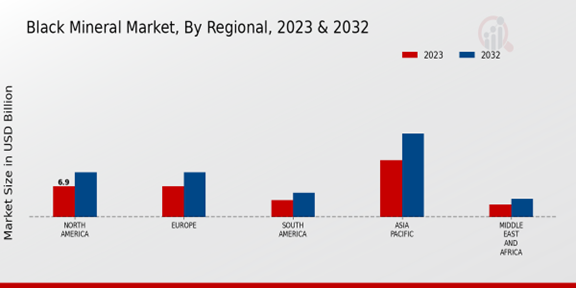Market Growth Projections
The Global Black Mineral Market Industry is projected to experience substantial growth in the coming years. The market is expected to reach a value of 30.3 USD Billion in 2024, with further growth anticipated to 45.4 USD Billion by 2035. This growth trajectory suggests a compound annual growth rate of 3.73% from 2025 to 2035. Various factors, including technological advancements, increasing demand for renewable energy, and expanding industrial applications, are likely to contribute to this positive outlook. The market's dynamics indicate a robust future for black minerals on a global scale.
Growing Industrial Applications
The Global Black Mineral Market Industry is witnessing growth due to the expanding industrial applications of black minerals. Industries such as construction, automotive, and electronics increasingly utilize black minerals for various applications, including coatings, lubricants, and composites. The versatility of these minerals allows them to meet diverse industrial needs, which is likely to drive demand. As industries continue to innovate and seek materials that enhance product performance, the market for black minerals is expected to flourish. This trend is anticipated to contribute to the market's growth trajectory, with a projected value of 45.4 USD Billion by 2035.
Technological Advancements in Mining
Technological advancements in mining processes are significantly impacting the Global Black Mineral Market Industry. Innovations such as automated mining equipment and advanced geological modeling are enhancing extraction efficiency and reducing operational costs. These improvements not only increase the yield of black minerals but also minimize environmental impacts, aligning with global sustainability goals. As mining companies adopt these technologies, the overall productivity of black mineral extraction is likely to improve, thereby supporting market growth. The integration of these technologies could be a pivotal factor in achieving the projected market value of 30.3 USD Billion in 2024.
Increasing Demand for Renewable Energy
The Global Black Mineral Market Industry is experiencing a surge in demand driven by the increasing adoption of renewable energy technologies. Black minerals, such as graphite, are essential in the production of batteries for electric vehicles and energy storage systems. As countries worldwide commit to reducing carbon emissions, the need for efficient energy storage solutions is likely to rise. This trend is expected to contribute to the market's growth, with projections indicating a market value of 30.3 USD Billion in 2024, potentially reaching 45.4 USD Billion by 2035, reflecting a compound annual growth rate of 3.73% from 2025 to 2035.
Rising Investment in Infrastructure Development
The Global Black Mineral Market Industry is poised for growth due to rising investments in infrastructure development worldwide. Governments and private sectors are allocating substantial funds to enhance transportation, energy, and communication infrastructures. Black minerals, particularly those used in construction and energy applications, are critical to these projects. As infrastructure development accelerates, the demand for black minerals is likely to increase, thereby driving market growth. This trend aligns with the anticipated market value of 30.3 USD Billion in 2024, with expectations of reaching 45.4 USD Billion by 2035.
Regulatory Support for Sustainable Mining Practices
Regulatory frameworks promoting sustainable mining practices are influencing the Global Black Mineral Market Industry positively. Governments are increasingly implementing policies that encourage environmentally responsible mining operations. These regulations not only aim to protect natural resources but also incentivize companies to adopt sustainable practices. As a result, the black mineral sector is likely to benefit from enhanced public perception and increased investment. This supportive regulatory environment may facilitate the growth of the market, contributing to the projected compound annual growth rate of 3.73% from 2025 to 2035.












Leave a Comment